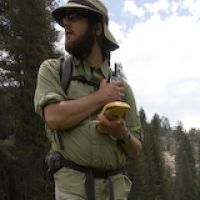Lucas & Conklin, 2012
Groundwater-surface water interactions in montane meadows of the Sierra Nevada, California.
Lucas, R., Conklin, M. (2012)
Fall meeting, American Geophysical Union, December 2012. Abstract H13D-1381.
-
Sierra, GRAD STUDENT
-
Sierra, INVESTIGATOR
Abstract
Meadows often lie in low gradient, groundwater fed terrain of the Sierra Nevada. These settings result in near saturated conditions for much of the year, shallow groundwater tables, and groundwater discharge to surface flow. Our hypothesis is that groundwater fluctuations integrate watershed processes rather than meadow specific processes. Meadow characteristics are in contrast to the adjacent forested landscapes, where soils go dry in the summer, groundwater tables are much deeper, and some fraction of soil water is lost to deeper percolation. We utilize a series water column data from monitoring wells and piezometers in two meadows, soil moisture and snow depth data from nodes in the associated catchment, located within the Southern Sierra Critical Zone Observatory, from water years 2008-2012. Water samples from wells and associated streams were analyzed for major ions and stable water isotopes. Results from the monitoring wells and piezometers show groundwater tables and pressure heads that are highest during snowmelt and decrease over the summer growing season; inter-annual variation is correlated to total accumulated precipitation for the given water year. Groundwater elevations exhibit diurnal fluctuations influenced by snowmelt and evapotranspiration (ET) processes in the spring, transitioning to an ET dominated signal during the summer growing season. These fluctuations are of greatest magnitude near the meadow-forest boundary and least near the center of the meadow. ET signals continue after the meadow vegetation senesces, suggesting influences from the adjacent forested landscape. Deep piezometers (>2.5 m depth) do not exhibit fluctuation at the daily time scale while shallower piezometers (<1 m depth) tend to show some fluctuation at this time interval. Further analysis of the piezometer data shows seasonal variation in the direction and magnitude of groundwater flux. Both near the meadow edge and meadow center, groundwater discharge is strongest during snow melt with a decrease as the summer growing season progresses. The near edge pressure head data show that the direction of groundwater flux changes to indicate groundwater recharge by fall. The near center data indicate groundwater discharge for the entirety of the summer growing season—long after the adjacent forest soils have dried out. Analysis of the geochemical data show that major ion concentrations vary little within the individual wells but vary from the edge of the meadow to the center. Stream water samples show surface flow is dominated by snow melt in the spring and is influenced more by subsurface flow as the growing season progresses. Groundwater discharges into the center of the meadows, long after the soils the adjacent Forests have dried out. This is consistent with the results from our geochemical analysis that suggests the surface water leaving the meadow systems is more influenced by subsurface flow later in the summer. Consistent groundwater discharge, with little variation in the geochemical profile of the groundwater, suggests a shallow groundwater source that is not being fully utilized by the adjacent forest landscape. These montane meadow systems provide a window for investigating groundwater surface water interactions in the catchments of the Southern Sierra Critical Zone Observatory.
Citation
Lucas, R., Conklin, M. (2012): Groundwater-surface water interactions in montane meadows of the Sierra Nevada, California. Fall meeting, American Geophysical Union, December 2012. Abstract H13D-1381..
Explore Further


